As carbon markets evolve, demand for high-integrity credits is set to outpace supply as early as 2030 - with some buyers already feeling the squeeze. In our recent webinar, “Buying Smart: How to Avoid the Carbon Credit Crunch,” experts from across the carbon ecosystem shared practical strategies for navigating this critical moment.
Moderated by Client Solutions Director Natalie Taylor, the discussion featured insights from our Product Development Manager, Shachar Hatan, and Head of Client Sustainability and Environment at Freshfields, Jake Reynolds.
Check out the complete recording of this insightful session, or if you’re short on time continue reading for a summary of the key takeaways.

1. What’s Driving the Carbon Credit Crunch?
The crunch is real - and it's being driven by several converging forces. As more companies commit to net zero, demand for high-quality removal credits has soared. Yet the supply of projects meeting increasingly aligned and rigorous standards hasn’t kept pace.
Below is a graph from our recent study into the climate commitments of the Fortune Global 500, which illustrates the predicted spike in claims and credit purchases.
Natalie Taylor, Director in Client Solutions, described the current environment plainly:
“If we have any chance of reaching net zero by 2050 demand for those high-quality removal projects is going to continue to rise and it's going to outstrip supply.”
The team then showed an example of how long-term purchase agreements are already helping real clients cope with an evolving market and save money.
Illustrated in the graph below is £450,000 of savings achieved by a real client through a forward agreement from 2020 to 2022. This global corporation would have saved an additional £2 million by extending that purchase agreement three more years, through to 2025.
The takeaway? Buyers must act early and strategically to secure the credits they need - without compromising on integrity.
2. Choosing the Right Purchase Method - and Partner
The method of procuring credits can significantly influence both cost and quality. The panel discussed several approaches:
- Pay as you go – buy credits and pay today
- Forward Agreement – commit now, pay in the future
- Project development – fund an entire new project
While pay as you go purchases offer flexibility, forward agreements secure future supply at predictable cost and signal commitment to the market.
Mixed Approach: Blending pay as you go and forward contracts offers a hedge against price volatility and delivery risks.
Selecting the Right Partner: When selecting a long-term partner, consider the services they provide beyond carbon, from market knowledge to due diligence and communications support.
The overarching theme? How you buy can be as important as what you buy. Organizations are increasingly moving toward forward contracts and offtake agreements to lock in access to high-quality supply.
3. Spotlight: Freshfields’ Long-Term Procurement Strategy
Jake Reynolds, Head of Client Sustainability and Environment at Freshfields, a global law firm, shared a firsthand account of developing a forward-looking carbon credit procurement strategy.
“At Freshfields we’d been offsetting on a pay-as-you-go basis for about 10 years,” explained Jake. “We’d experienced fluctuating prices, inconsistency in our portfolio, and an annual due diligence and contracting burden; all of these were contributing factors [that drove us to make a long term commitment]."
"But probably the most significant factor was our desire to deliver impact: we wanted to find a high quality project that was delivering real social value beyond just climate impact, and we wanted to use our purchasing power to support and fund the long-term growth of the project.” - Jake Reynolds, Freshfields
Through the Reforestation in East Africa Program (REAP) Freshfields made a 10-year commitment that allowed them to impact over 180 communities, while also locking in high-quality carbon credits at a reliable price.
“A 10 year commitment is quite significant,” said Jake. “But actually a strong supporter of the program was our CFO, and there's lots of reasons why that is the case, but one of them was price certainty. We locked in a good value price because we were willing to make that long-term commitment over the following 10 years.”
Jake added on the REAP program: “It's part of a rich story we can tell to our colleagues and to the communities where this project has been working about how an international organization like our own is making a modest but long term impact."
Freshfields’ approach highlights the value of moving early, thinking long-term, and embedding integrity into every step of the procurement process.
Final Takeaway: Act Smart, Act Now
As the carbon market evolves, businesses must act decisively to secure high-quality credits that align with their climate goals. From understanding the market crunch to building a high-integrity portfolio and choosing the right procurement method, it’s clear that strategic, long-term thinking is essential.
Whether you're just starting your journey or looking to strengthen your current approach, Climate Impact Partners is here to help. Our team brings deep expertise, trusted partnerships, and a commitment to climate integrity.
Get in touch with Climate Impact Partners today to discuss a carbon credit procurement strategy tailored to your business - so you can meet your goals with confidence and credibility.
A 10 year commitment is quite significant, but actually a strong supporter of the program was our CFO, and there's lots of reasons why that is the case, but one of them was price certainty.












